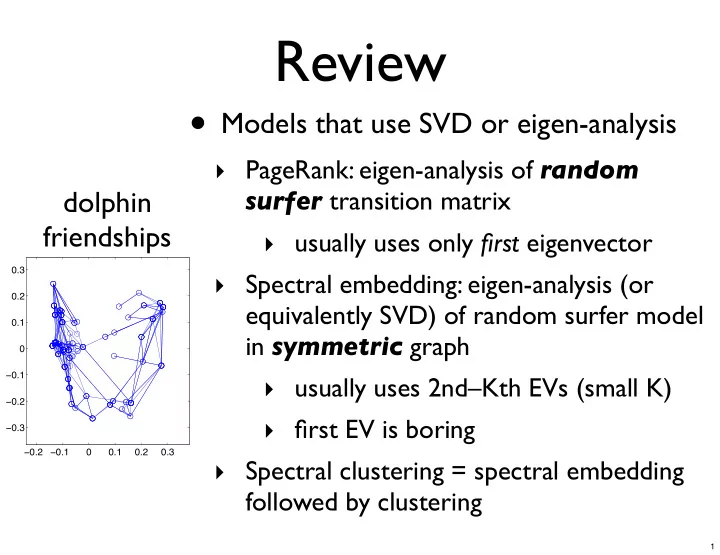

Review • Models that use SVD or eigen-analysis ‣ PageRank: eigen-analysis of random dolphin surfer transition matrix friendships ‣ usually uses only first eigenvector !"% ‣ Spectral embedding: eigen-analysis (or !"# equivalently SVD) of random surfer model !"$ in symmetric graph ! ! !"$ ‣ usually uses 2nd–Kth EVs (small K) ! !"# ‣ first EV is boring ! !"% ! !"# ! !"$ ! !"$ !"# !"% ‣ Spectral clustering = spectral embedding followed by clustering 1
Review: PCA • The good: simple, successful • The bad: linear, Gaussian ‣ E(X) = UV T ‣ X, U, V ~ Gaussian • The ugly: failure to generalize to new entities ‣ Partial answer: hierarchical PCA 2
What about the second rating for a new user? • MLE/MAP of U i ⋅ from one rating: ‣ knowing μ U : ‣ result: • How should we fix? • Note: often have only a few ratings per user 3
MCMC for PCA Need: • Can do Bayesian inference by Gibbs sampling—for simplicity, assume σ s known 4
Recognizing a Gaussian • Suppose X ~ N(X | μ , σ 2 ) • L = –log P(X=x | μ , σ 2 ) = ‣ dL/dx = ‣ d 2 L/dx 2 = • So: if we see d 2 L/dx 2 = a, dL/dx = a(x – b) ‣ μ = σ 2 = 5
Gibbs step for an element of μ U • L = 6
Gibbs: element of U • L = • dL / dU ik = • dL 2 / (dU ik ) 2 = ‣ post. mean = post. var. = 7
In reality • Above, blocks are single elements of U or V • Better: blocks are entire rows of U or V ‣ take gradient, Hessian to get mean, covariance ‣ formulas look a lot like linear regression (normal equations) • And, want to fit σ U , σ V too ‣ sample 1/ σ 2 from a Gamma (or Σ –1 from a Wishart ) distribution 8
Nonlinearity: conjunctive features P(rent) Foreign Comedy 9
Disjunctive features P(rent) Comedy Foreign 10
Non-Gaussian • X, U, and V could each be non-Gaussian ‣ e.g., binary! ‣ rents(U, M), comedy(M), female(U) • For X: predicting –0.1 instead of 0 is only as bad as predicting +0.1 instead of 0 • For U, V: might infer –17% comedy or 32% female 11
Logistic PCA • Regular PCA: X ij ~ N(U i ⋅ V j , σ 2 ) • Logistic PCA: • Might expect learning, inference to be hard ‣ but, MH works well, using dL/d θ , d 2 L/d θ 2 • Generalization: exponential family PCA ‣ w/ optional hierarchy, Bayesianism 12
Application: fMRI Brain activity fMRI :-) stimulus: “dog” fMRI ;-> stimulus: “cat” fMRI stimulus: “hammer” :-)) credit: Ajit Singh Voxels Stimulus Y 13
2-matrix model Z p Σ U U i Σ Z Σ Z X ij Y jp i = 1 . . . n µ U p = 1 . . . r µ Z V j co-occurrences fMRI voxels j = 1 . . . m (logistic PCA) (linear PCA) Σ V µ V 14
Results (logistic PCA) Y (fMRI data): Fold-in 1.4 HB � CMF H � CMF Maximum a posteriori (fixed hyperparameters) 1.2 CMF 1 Mean Squared Error 0.8 Lower is credit: Ajit Singh 0.6 0.4 Better 0.2 0 Augmenting fMRI data with Just using fMRI data word co-occurrence 15
Recommend
More recommend